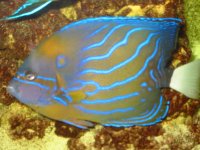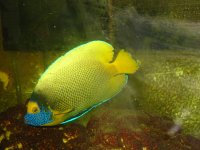I am having trouble getting rid of what appears to be a bacterial problem, and have lost a few fish.
I have a 90 gal fish only, with about 80 lbs of live rock, wet/dry trickle filter, skimmer, and 25 watt UV sterilizer.
I have been fighting this problem for about 2 months now, and can't seem to get the upper hand.
It started with the death of a blue bird wrass. When I pulled him out, he had severe fin rot and sloughing scales/open sores in his abdomen. At the same time, my large 6 bar Angel, Queen Angel, and blue-face angel started showing signs of fin rot, and then my blue line grouper started showing signs of fin rot along with some kind of possible parasite. The grouper has small white spots, which don't appear to be Ich. No other fish seem to havve these white spots These are all fairly large fish. My large purple tang and tomato clown have shown no signs of problems.
The next fish to go was the Queen Angel. The fish died very quickly, and had been feeding the previous day. Whatever this is, I can't seem to get rid of. I have treated with Maracyn for a week, switched to Furacyn for a week, and am know on my second week of Maracyn II, which appears to be helping slightly. Attached is the picture of the six bar and problem areas. Note the damage on the fins. The yellow side fins are stubs. The tail is a bit ragged also.
Any ideas? These fish have been in this tank for about 4 years. All water conditions are fine, I do about a 20 gal water change with RO water once a month.
Thanks!
I have a 90 gal fish only, with about 80 lbs of live rock, wet/dry trickle filter, skimmer, and 25 watt UV sterilizer.
I have been fighting this problem for about 2 months now, and can't seem to get the upper hand.
It started with the death of a blue bird wrass. When I pulled him out, he had severe fin rot and sloughing scales/open sores in his abdomen. At the same time, my large 6 bar Angel, Queen Angel, and blue-face angel started showing signs of fin rot, and then my blue line grouper started showing signs of fin rot along with some kind of possible parasite. The grouper has small white spots, which don't appear to be Ich. No other fish seem to havve these white spots These are all fairly large fish. My large purple tang and tomato clown have shown no signs of problems.
The next fish to go was the Queen Angel. The fish died very quickly, and had been feeding the previous day. Whatever this is, I can't seem to get rid of. I have treated with Maracyn for a week, switched to Furacyn for a week, and am know on my second week of Maracyn II, which appears to be helping slightly. Attached is the picture of the six bar and problem areas. Note the damage on the fins. The yellow side fins are stubs. The tail is a bit ragged also.
Any ideas? These fish have been in this tank for about 4 years. All water conditions are fine, I do about a 20 gal water change with RO water once a month.
Thanks!





